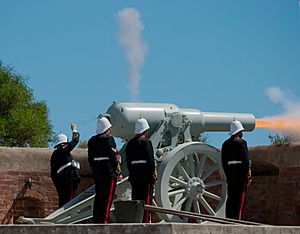RML 64-pounder 64 cwt gun facts for kids
Quick facts for kids RML 64-pounder 64 cwt gun |
|
|---|---|

Fortification mounted MK III gun firing at Fort Glanville Conservation Park, South Australia
|
|
| Type | Naval gun Fortification gun |
| Place of origin | United Kingdom |
| Service history | |
| In service | 1865–190? |
| Used by | British Empire |
| Production history | |
| Designer | Woolwich Arsenal |
| Designed | 1864 |
| Manufacturer | Woolwich Arsenal Elswick Ordnance Company |
| Variants | Mk I, II, III |
| Specifications | |
| Mass | 64-long-hundredweight (3,300 kg) |
| Length | 9 ft 10 inches |
| Barrel length | 97.5 inches bore |
|
|
|
| Shell | 64 pounds (29 kg) |
| Calibre | 6.3 inches (160 mm) |
| Action | RML |
| Breech | None – muzzle-loading |
| Muzzle velocity | Wrought-iron tube : 1,252 feet per second (382 m/s) Mk III steel tube : 1,390 feet per second (420 m/s) |
| Effective firing range | 5,000 yards (4,600 m) |
The RML 64-pounder 64 cwt gun was a powerful cannon used in the 1800s. It was made in England and could be used on ships, in battles on land, or to defend forts. This gun fired a heavy projectile, like a giant bullet, that weighed about 64 pounds (around 29 kilograms).
The "RML" in its name stands for "Rifled, Muzzle Loading." This means the inside of the gun's barrel had spiral grooves (rifling) to make the projectile spin, helping it fly straighter and farther. "Muzzle Loading" means the cannonball and gunpowder were loaded from the front end of the barrel. The "64 cwt" part of its name tells us the gun itself weighed about 64 hundredweight, which is a way to measure weight. This helped people tell it apart from other 64-pounder guns.
Contents
How the 64-Pounder Gun Worked
This gun had a special design. Its barrel was 6.3 inches (about 160 millimeters) wide. This size was chosen so it could still use old cannonballs that were made for older, less powerful 32-pounder guns.
Different Versions of the Gun
There were a few different versions, or "Marks," of this gun:
- Mark I guns were first used in 1864.
- Mark II guns came out in 1866.
- Mark III guns were made starting in 1867.
The early Mark I, Mark II, and some Mark III guns had an inner tube made of strong wrought-iron. This tube was wrapped with more wrought-iron coils to make it even stronger.
Later Mark III guns, made after April 1871, were built with a tougher inner tube made of mild steel. Older Mark III guns were even updated with these new steel tubes. These steel-tubed guns were often used as "siege guns" on land, meaning they were used to attack forts. Guns that still had the iron tubes were mostly used on ships.
Rifling for Accuracy
All these guns had three spiral grooves inside their barrels. These grooves made the cannonball spin as it left the gun. This spin helped the projectile fly more accurately and reach targets up to 5,000 yards (about 4,572 meters) away.
Ammunition Used
The RML 64-pounder gun could fire different types of projectiles.
Common Shells
The most common type was called a "common shell." This was used to hit enemy troops hiding behind cover, damage ships, or break down buildings. When empty, this shell weighed about 57.4 pounds (26 kilograms). It was filled with about 7.1 pounds (3.2 kilograms) of explosive material.
Shrapnel Shells
The gun could also fire "shrapnel shells." These were designed to explode in the air and spray out many small metal balls, like a giant shotgun. A shrapnel shell weighed about 66.6 pounds (30.2 kilograms) and contained 234 metal balls, along with a small bursting charge to make it explode.
Where to See These Guns Today
Many of these historic RML 64-pounder guns still exist around the world! You can find them in museums and old forts.
- The only surviving Mark I gun is at Fort George in Scotland.
- Mark II and Mark III guns can also be seen at Fort George, near Inverness, Scotland.
- A Mark III gun (number 17) is on board HMS Gannet at Chatham Dockyard in the UK.
- You can see Mark III gun number 294, made in 1867, at Nothe Fort in Weymouth, UK.
- Another Mark III gun is located at Fort Brockhurst in Gosport, UK.
- Two Mark III guns, including number 318 from 1867, are at Pendennis Castle in Cornwall, UK.
- At Fort Glanville Conservation Park in Adelaide, South Australia, you can find Mark III guns number 462 and 463.
- A Mark III gun (number 739, dated 1878) is displayed in Townsville, Queensland, Australia.
- Mark III gun number 742, also from 1878, is in Queens Park Toowoomba, Queensland, Australia. This gun was once used by the Queensland colonial navy.
- Two Mark III guns, including number 729 from 1878, are at the Fort Lytton Historic Military Precinct in Brisbane, Australia.
- You can see these guns at the Central Battery of Lei Yue Mun Fort in Hong Kong.
- There are six guns at Fort Siloso in Singapore, including Mark III gun Number 767, made in 1874.
- A Mark III gun is also at Albert Park, Auckland in Auckland, New Zealand.
Images for kids
-
The sole surviving Mk I gun, at Fort George, Scotland.




